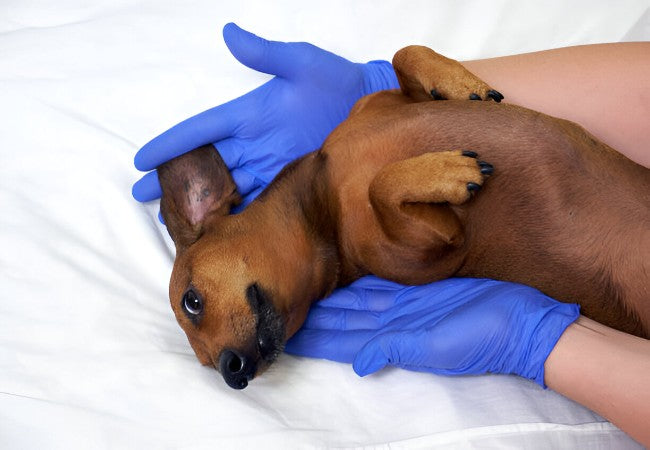Vet’s 2025 Guide to Lymphoma in Dogs 🩺🐾

In this article
Vet’s 2025 Guide to Lymphoma in Dogs 🩺🐾
By Dr. Duncan Houston BVSc
Lymphoma is the most common cancer in dogs, affecting lymphocytes in lymph nodes, spleen, bone marrow & other organs. Thankfully, certain types are highly treatable with chemotherapy. In this 2025 guide, gain a deep understanding of lymphoma types, signs, staging, diagnostics, modern treatments—including Tanovea®—and supportive strategies utilizing Ask A Vet. 🐶
1️⃣ What Is Canine Lymphoma?
Lymphoma, or lymphosarcoma, is a group of cancers originating from malignant lymphocytes. It may appear in lymph nodes (multicentric), GI tract (alimentary), chest (mediastinal), skin (cutaneous), or other organs.
2️⃣ How Common & Who's Affected?
- Accounts for 15–20% of canine cancers and ~80 % of blood-cell tumors.
- Middle-aged to older dogs are most affected, though any breed can be involved.
- Breed predispositions include Boxers, Bulldogs, Golden Retrievers, Rottweilers, Beagles, German Shepherds, Basset Hounds, Scots Terriers.
3️⃣ Signs & Physical Findings
- Painless enlarged lymph nodes—often under the jaw, armpits, groin.
- Lethargy, reduced appetite, weight loss.
- Depends on type: GI lymphoma causes vomiting/diarrhea; mediastinal lymphoma may lead to breathing issues or hypercalcemia.
4️⃣ Staging Details
Staging I–V (plus substage a for asymptomatic, b for systemic illness) indicates spread and guides treatment. Higher stages and b-substage indicate more advanced disease.
5️⃣ How It’s Diagnosed
- Fine-needle aspiration (FNA): cytology from nodes offers prompt diagnosis.
- Biopsy & histopathology: confirms cell type and subtype.
- Immunophenotyping & PCR (PARR): distinguishes B‑cell vs T‑cell lymphoma.
- Staging tests: include bloodwork, urinalysis, chest and abdominal imaging, and bone marrow aspirate.
6️⃣ Treatment Options in 2025
💉 Multi-agent Chemotherapy
The gold standard: CHOP protocols using cyclophosphamide, doxorubicin, vincristine, prednisone, often yielding 6–12 months average survival.
📅 Radiotherapy
Useful for localized or resistant disease
🧬 New & Targeted Treatments
Tanovea® (rabacfosadine) is the first FDA-approved lymphoma drug for dogs, showing promise as part of treatment plans.
⚖️ Palliative & Alternative Strategies
Prednisone alone may improve quality of life for ~1–2 months if full chemo isn't feasible.
7️⃣ Prognosis by Type & Treatment
- Untreated: survival 4–6 weeks.
- Chemo-treated multicentric lymphoma: median survival ~12 months; B-cell ~12 mo, T-cell ~6–9 mo.
- Cutaneous, alimentary, mediastinal: variable—generally shorter than multicentric.
- Poorer prognosis with T-cell immunophenotype or substage b.
8️⃣ Monitoring & Follow‑Up
- Palpate lymph nodes regularly, ideally weekly, during treatment.
- Bloodwork before each chemo dose to check organ function and counts.
- Imaging periodically to assess response or disease recurrence.
- Consider molecular markers or blood tests as future relapse indicators.
9️⃣ Supportive Care & Brand Integration
- Manage side effects—anti-nausea, appetite stimulants, ear care.
- Maintain nutrition with high-quality, calorically dense food.
- Ask A Vet: for telehealth check-ins, symptom support, med adherence.
🔟 When to Contact Your Vet
- New lumps or swelling of lymph nodes.
- Lethargy, appetite loss, vomiting, diarrhea.
- Severe or persistent side effects during chemo.
- Signs of relapse—coughing, breathing difficulty, neurological changes.
🏁 Final Thoughts
With early detection and comprehensive treatment, many dogs enter prolonged remission, even beyond a year. Advances like Tanovea®, better staging techniques, and strong supportive care (including Ask A Vet telehealth) mean higher quality of life than ever before in 2025. With vigilance and TLC, lymphoma can be a treatable journey, not the end. 🐶❤️
Need help navigating treatment stages, side effects, or recovery support? Visit AskAVet.com and download the Ask A Vet app—24/7 veterinary support when it matters most. 📱🐾






